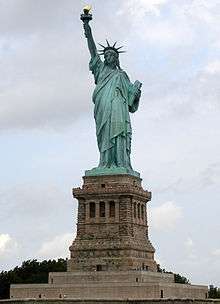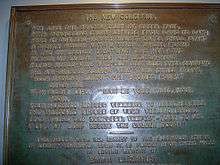The New Colossus
| The New Colossus | |
|---|---|
 Emma Lazarus's manuscript | |
| Created | 1883 |
| Location | Statue of Liberty, Liberty Island, New York City, New York, U.S.[1] |
| Author(s) | Emma Lazarus |
| Purpose | Sonnet was engraved on a bronze plaque and mounted inside the monument in 1903 |
"The New Colossus" is a sonnet that American poet Emma Lazarus (1849–1887) wrote in 1883 to raise money for the construction of the pedestal of the Statue of Liberty.[2] In 1903, the poem was engraved on a bronze plaque and mounted inside the pedestal's lower level.
History of the poem

This poem was written as a donation to an auction of art and literary works[3] conducted by the "Art Loan Fund Exhibition in Aid of the Bartholdi Pedestal Fund for the Statue of Liberty" to raise money for the pedestal's construction.[4] Lazarus's contribution was solicited by fundraiser William Maxwell Evarts. Initially she refused but Constance Cary Harrison convinced her that the statue would be of great significance to immigrants sailing into the harbor.[5]
"The New Colossus" was the first entry read at the exhibit's opening, but was forgotten and played no role at the opening of the statue in 1886. In 1901, Lazarus's friend Georgina Schuyler began an effort to memorialize Lazarus and her poem, which succeeded in 1903 when a plaque bearing the text of the poem was put on the inner wall of the pedestal of the Statue of Liberty.[4]
The line "Keep, ancient lands, your storied pomp!" has read "Keep ancient lands, your storied pomp!" on the plaque hanging inside the Statue of Liberty[6] since its unveiling in 1903.
The original manuscript is held by the American Jewish Historical Society.[7]
Contents
.jpg)
Not like the brazen giant of Greek fame,
With conquering limbs astride from land to land;
Here at our sea-washed, sunset gates shall stand
A mighty woman with a torch, whose flame
Is the imprisoned lightning, and her name
Mother of Exiles. From her beacon-hand
Glows world-wide welcome; her mild eyes command
The air-bridged harbor that twin cities frame.
"Keep, ancient lands, your storied pomp!" cries she
With silent lips. "Give me your tired, your poor,
Your huddled masses yearning to breathe free,
The wretched refuse of your teeming shore.
Send these, the homeless, tempest-tost to me,
I lift my lamp beside the golden door!"
The title of the poem and the first two lines refer to the Colossus of Rhodes, which was one of the Seven Wonders of the Ancient World, sometimes described as standing astride the harbor.
The "sea-washed, sunset gates" are the mouths of the Hudson and East Rivers, to the west of Brooklyn. The "imprisoned lightning" refers to the electric light in the torch, then a novelty.
The "air-bridged harbor that twin cities frame" refers to New York Harbour between New York City and Brooklyn, which were consolidated into one unit in 1898, 15 years after the poem was written.
The "huddled masses" are the many immigrants coming to the United States (many of them through Ellis Island at the port of New York).
Influence

Paul Auster wrote that "Bartholdi's gigantic effigy was originally intended as a monument to the principles of international republicanism, but 'The New Colossus' reinvented the statue's purpose, turning Liberty into a welcoming mother, a symbol of hope to the outcasts and downtrodden of the world."[8]
John T. Cunningham wrote that "The Statue of Liberty was not conceived and sculpted as a symbol of immigration, but it quickly became so as immigrant ships passed under the torch and the shining face, heading toward Ellis Island. However, it was [Lazarus's poem] that permanently stamped on Miss Liberty the role of unofficial greeter of incoming immigrants."[9]
The poem has entered the political realm. It was quoted in John F. Kennedy's book A Nation of Immigrants (1958)[10] as well as a 2010 political speech by President Obama advocating immigration policy reform.[11]
Parts of the poem also appear in popular culture. The Broadway musical Miss Liberty, with music and lyrics by Irving Berlin, an immigrant himself, used final stanza beginning "Give me your tired, your poor" as the basis for a song.[12][13] It was also read in the 1941 film Hold Back the Dawn as well as being recited by the heroine in Alfred Hitchcock's wartime film Saboteur.[13] Harpist and singer Joanna Newsom indirectly references the poem in her 2015 song "Sapokanikan," in contrast to the forbidding colossus of Percy Bysshe Shelley's "Ozymandias."[14]
References
- ↑ "Statue of Liberty National Monument". US: National Park Service. 2007-12-31. Retrieved 2008-07-24.
- ↑ Lazarus, Emma, The New Colossus, Liberty State Park
- ↑ Sutherland, Cara A (2003), The Statue of Liberty: The Museum of the City of New York, Barnes & Noble, p. 77, ISBN 0-7607-3890-4,
auction of art and literary work
; Mark Twain also contributed. - 1 2 Young, Bette Roth (1997), Emma Lazarus in Her World: Life and Letters, The Jewish Publication Society, p. 3, ISBN 0-8276-0618-4,
…fell into obscurity. At the unveiling of the statue […] both Emma and her sonnet were absent […] Georgina Schuyler set in motion a successful attempt to memorialize her friend by placing the poem, inscribed on a bronze tablet, inside the pedestal…
. - ↑ Felder, Deborah G; Rosen, Diana L (2003), Fifty Jewish Women Who Changed the World, Citadel, p. 45, ISBN 0-8065-2443-X,
…William Maxwell Evert [sic; presumably a misspelling of "William Maxwell Evarts] asked […] Lazarus[…] to compose original works […] who […] refused […] until […] Constance Cary Harrison[…] suggested that she consider what the statue would mean to the thousand of immigrants who would see it as they sailed into New York…
. - ↑ Shapiro, Gary (2006-12-08). "Misprint is spied in Lazarus poem at Liberty island". The New York Sun. Retrieved 2007-06-08.
- ↑ Roberts, Sam (2011), "How a Sonnet Made a Statue the 'Mother of Exiles'", New York Times, retrieved 2013-11-21
- ↑ Auster, Paul (2005), "NYC = USA", Collected Prose: Autobiographical Writings, True Stories, Critical Essays, Prefaces, and Collaborations with Artists, Picador, p. 508, ISBN 0-312-42468-X.
- ↑ Cunningham, John T (2003), Ellis Island: Immigration's Shining Center, Arcadia Publishing, pp. 46–48, ISBN 0-7385-2428-X.
- ↑ McGill, Meredith L. (2008). The Traffic in Poems: Nineteenth-century Poetry and Transatlantic Exchange. Rutgers University Press. p. 118.
- ↑ Jackson, David (July 1, 2010). "Obama edits Emma Lazarus poem on Statue of Liberty". The Oval. USA Today. Retrieved July 15, 2015.
- ↑ Esther Schor, Emma Lazarus, Knopf Doubleday Publishing Group - 2008, page 255
- 1 2 Meredith L. McGill, The Traffic in Poems: Nineteenth-century Poetry and Transatlantic Exchange, Rutgers University Press - 2008, page 118
- ↑ Hicks, Michael (2015-11-08). ""'The text will not yield': Fleeting Tesserae in Joanna Newsom's Sapokanikan"". Medium. Retrieved 2016-06-09.
External links
| Wikisource has original text related to this article: |
- Lazarus, Emma, "The new Colossus", A Century of Immigration, 1820–1924 (handwritten) (sonnet), Library of Congress. The latter page says "Courtesy of the American Jewish Historical Society, New York and Newton Centre, Massachusetts". The poem itself, having been published in 1883 or at the very latest 1903 is in the public domain
- ———, Schor, Esther, ed., The New Colossus (interactive ed.), Nextbook Press External link in
|publisher=(help). - Manuscript notebook from the Emma Lazarus collection at the American Jewish Historical Society. Includes an undated manuscript version of "The New Colossus."
- Marom, Daniel (2000). "Who is the 'Mother of Exiles'? An Inquiry into Jewish Aspects of Emma Lazarus's 'The New Colossus'". Prooftexts. 20 (3): 231–61. doi:10.1353/ptx.2000.0020.